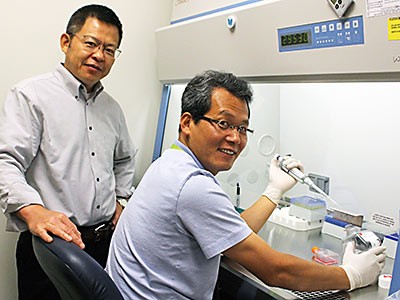KO Hamster Model
The KO Hamster Model is a genetically modified Golden Syrian hamster that allows researchers to study human diseases more accurately. This saves researchers time as it makes the results of their studies more accurate, reducing the number of trials and studies that need to be conducted.
Problem
Small animal models, such as mice and rat models, are the primary models used to study human disease treatment, but these models have limited effectiveness as they do not closely reflect humans’ responses to diseases and treatments.
Solution
The KO Hamster Model is a proprietary genetic engineering technology that allows researchers to more accurately study human diseases. Gene targeting is not naturally possible in hamsters, so researchers used CRISPR/Cas9 genetic engineering technologies to develop this model. Researchers established the first piggyBac-mediated transgenic technologies in the species. This technique allows researchers to create various gene knockout models (KO), a model that makes one of the hamster’s genes inoperative so the gene can be studied more in depth. There are several versions of this model so researchers can study several diseases.
Benefits
Hamster models demonstrate human reactions better than other small animal models, so this technology will save researchers time and money because they will be able to more accurately produce and verify results in fewer studies. Golden Syrian hamster models have an advantage over other small animal models as hamsters and humans have a similar physiology and lipid metabolism. This allows researchers to improve their understanding of how diseases affect genes. Hamsters are also highly sensitive to western diet-induced obesity and can develop insulin resistance, allowing researchers to more accurately model human treatment methods.
Applications
Researchers hope to use this genetic engineering technology to study additional diseases, such as type II diabetes, to improve insulin resistance, beta cell function and arrhythmia. The model is a better way to study human stem cells, infectious diseases caused by human-specific pathogens, gene therapy for blood diseases, human cancer and drug testing.
Researchers developed this model to study various diseases including colorectal cancer, LQTS and metabolic syndromes that are caused by a loss of function of the KCNQ1 gene. Other genes, including LIMD1, OP2, OPN4, OPN5, hTfR1 (Junin virus infection), RAG1 and RAG2, and IL2-Rcg, can also be studied using this model.

Contact
Questions about this technology including licensing availability can be directed to:
Christian S. Iverson, MBA
Executive Director, Technology Transfer Services
(435) 797-9620 christian.iverson@usu.edu
USU ID
C18049
| Hamster Model | Status | Applications |
|---|---|---|
| STAT2 KO | Available | Model of viral infections: AdV, EBOV, DENV, HRTV, SFTSV, RSV, CCHFV, USUV, Kyasanur Forest disease virus (KFDV), Alkhurma virus (ALKV), Mayaro virus, and ZIKV |
| RAG1 KO | In development | Model of VDJ recombination and its associated disease, viral and bacterial infection, cancer, and human stem cell transplantation (HSCT) |
| RAG2 KO | Line lost; being regenerated | Model of VDJ recombination and its associated disease, viral and bacterial infection, cancer, and human stem cell transplantation (HSCT) |
| IL-2Rcg KO | Line lost; being regenerated | Model of viral infection; cancer; human stem cell transplantation(HSCT) |
| P53 KO | Available | Model of cancer |
| hDPP4 KI | Available | Model of MERS-CoV infection, type 2 diabetes, and cardiovascular diseases |
| Per2:luc KI | Available | Model of circadian rhythm(CR) |
| Bmal1:luc KI | In development | Model of circadian rhythm(CR) |
| IFNLR1 KO | In development | Model of viral infection |
| KCNQ1 KO | Available | Model of colorectal cancer, LQTS, and metabolic syndromes |
| SMPD1 KO | In development | Model of inflammation and atherosclerosis |
| LIMD1 | Available | Model of cancer |
| Melanopsin OPN 3 | Available | Model of light responses, circadian rhythm and neuroendocrinology |
| OPN 4 | Available | Model of light responses, circadian rhythm and neuroendocrinology |
| OPN 5 | Available | Model of light responses, circadian rhythm and neuroendocrinology |
| hTfR1 | Available | Model of Junin virus infection |
Development Stage
TRL 4
Component validation in a laboratory environment.

